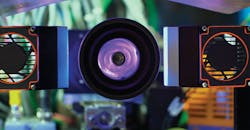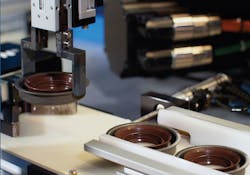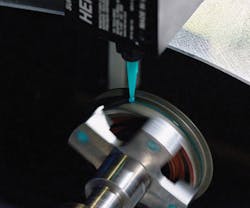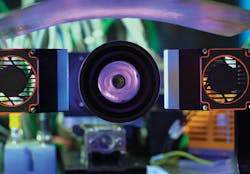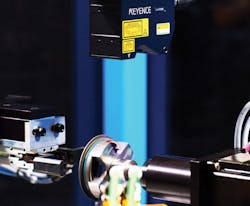UV-Cured Form-On Gasket Eliminates Waste and Health Concerns in Automotive Application
A Tier 1 automotive supplier had long relied on a solvent-based sealant to seal the joint between the oil-shaft seals on rotary shafts and the housings as they entered or exited crank cases and transmissions. While the shafts are secured using a rubber gasket, the outside of the seal (where it meets the housing) received an application of the solvent-based sealant. But when the sealant was applied, about 40% to 50% of it evaporated and was wasted.
The coloring agent in the sealant also evaporated and landed on nearby air vent surfaces, discoloring them and leaving a visible, growing reminder of air-quality and health concerns. The solvent problem became so significant that the supplier’s plant started receiving daily fines from the EPA. The company needed a solution to its sealant problem as soon as possible.
Management at the plant got in touch with engineers at Hernon Manufacturing, a leading adhesive and sealant developer, looking for a way to replace the solvent-based sealant but still tightly seal joints between oil shaft seals and housing. The goals of the project included removing solvents from the process and the associated mess they created, reducing health risks to employees, and speeding up any application process.
In response, Hernon engineers developed the UV Form-On Gasket (FOG) process. The first part of the development process was creating a sealant to replace the one the supplier was currently using. Hernon’s full-service lab designed a range of UV FOG formulas with a mix of several different photo-initiators to capture a large spectrum of UV light for thorough curing.
The sealants’ viscosity had to be tightly controlled to ensure they would not drip or run during application, but instead form a smooth, consistent bead. The sealants also needed to meet stringent compatibility standards with the oils, transmission fluids, and other liquids, as well as the elevated temperature common in combustion engines.
Oil shaft seals are picked up by a spindle robotic arm with a magnetic effector in preparation to dispense the UV FOG sealant.
The Hernon team tested the formulas to determine their physical and chemical properties against customer requirements and compatibility with dispensers, along with the possible motions and materials employed during dispensing. Once all specifications were met, samples of the best formula were sent to the customer for on-site evaluation.
The UV FOG sealant was designed to work with carefully calibrated UV LED curing lights built by Hernon. They were tuned to emit the best wavelength for triggering the photo-initiators embedded in the sealant that start the crosslinking process. One key capability of the new sealant was that it can be cured to a desired tackiness by adjusting UV exposure’s time and intensity. So, the finished sealant bead is soft and slightly sticky. This lets beads adjust their shapes to precisely fill gaps between the gasket and housing.
The spindle arm rotates the oil shaft seal, letting the stationary dispensing tip lay down a complete bead around the exterior of the seal that will cure into a tight gasket.
The Hernon team also designed and built the dispensing and curing equipment used to apply the UV FOG as part of its Total Solutions approach. That included a parts conveyor where intelligent sensors track part locations and communicate to robotic arms when parts are ready to enter active stages. Steel components are picked up with permanent magnets, reducing task complexity compared to pneumatics or electromagnets and minimizing energy consumption.
From the conveyor, seals are first moved to the dispensing station where the robotic spindle arm rotates the seal under one of Hernon’s proprietary SureShot 3000 valves. It puts a controlled steady bead of sealant onto the spinning seal. Once the bead is in place, parts are moved to a UV station and inserted into a housing where four high-intensity UV LED lights cure the bead to meet specified exposure times.
The bead of UV FOG is cured in place using lens focused UV LED curing lights. Several photoinitiators in the sealant are triggered by specific ranges of the UV spectrum to begin the crosslinking process. The end result is a gasketing bead that precisely conforms to the circumference of the seal.
In the final stage, a laser inspection checks the bead’s location and width, and ensures that it is continuous with no gaps. This laser inspection stage also includes a pass/fail station. If a part fails to meet any of the metrics, it is dropped into a bad-part bin. If it passes inspection, the part goes onto a conveyor which takes it out of the UV FOG machine.
Oil shaft seals coming off out of the UV FOG machine can be instantly used in the manufacturing process. Parts are processed at speeds of 12 to 15 parts per minute, depending on the size of the seal. The larger the size, the longer the needed dispensing and curing times.
The cured bead of UV FOG material is laser inspected against pass/fail metrics. The exact location of the bead, it’s width and height, and whether it is continuous or intermittent are all checked against specified parameters to ensure every part meets quality assurance standards.
With no solvents in the UV FOG Sealant, the automotive supplier’s health concerns over evaporated solvent and coloring agents were addressed and completely eliminated. The mess became a thing of the past and, by purchasing several dispensing machines, the customer increased its production.
Inquiries about UV FOG can be submitted at Hernon.com, e-mailed, or placed via phone at (888) 998-4720.
